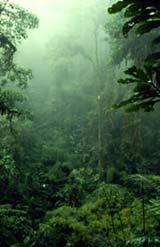Felling trees has sky-high price

Costa Rica’s lush mountain tops are loosing their mists. <br>© UAH
Deforestation is drying out cloud forests.
“It drips,” says ecologist Robert Lawton, describing the Costa Rican cloud forest, “and it’s plastered with plants of all sizes climbing over each other. Stand still for long and they’re growing on you.”
Now the lush life he describes may be threatened. Satellite pictures show that deforestation at the foot of western Costa Rican mountains is drying out swirling summit mists.
When warm, wet tradewinds blowing off the Caribbean are forced upwards by the mountains, they cool and condense into a damp fog. This supports 7358 square kilometers of forest at heights above 1,500 metres.
Where agriculture has eroded lowland forests, the fluffy cumulus clouds that feed the peaks’ forests no longer form, Lawton, of the University of Alabama in Huntsville, and colleagues report1. Water evaporating between the trees normally lowers the air temperature. In its absence, air is warmer and has to be lifted higher before it cools into mist.
“It’s extremely worrying,” says conservationist Philip Bubb of the Tropical Montane Cloud Forest Initiative in Cambridge, UK. The findings may explain why the base of the cloud forest has begun to dry out, killing many species of frogs and toads.
If lost, the forests would take more unique plants and animals with them. The peaks are isolated nests of biodiversity: “species of orchids might be found on only one mountain top,” says Bubb. Cloud forests also channel clean, fresh drinking water to people in towns below.
Tropical cloud forests on the mountain ranges of Central and South America, Africa and Asia could face a similar fate. Trees are being cleared apace in these countries to make plantations and animal pasture. Most of lowland Costa Rica has already been cleared.
The sky’s the limit
Lawton teamed up with atmospheric scientists to photograph cumulus clouds across Costa Rica and neighbouring Nicaragua using the Landsat and Geostationary Environmental Satellite (GEOS). Atmospheric models confirm that clouds which form above a treeless landscape form at a greater height than those over forest.
Declining species and mist in the Costa Rican rainforest have previously been attributed to climate change warming air over the sea, explains Alan Pounds of the Monteverde Cloud Forest Preserve and Tropical Science Center in Costa Rica2,3. Deforestation complements this idea, he thinks. Removing a buffer of trees may exacerbate global warming’s effects.
The satellite findings show that conservation plans must now take into account the entire landscape: “You can’t create a series of parks and expect biodiversity to be preserved,” says Pounds.
References
- Lawton, R. O., Nair, U. S., Pielke, R. A. & Welch, R.M. Climatic impact of tropical lowland deforestation on nearby montane cloud forests. Science, 294, 584 – 587, (2001).
- Pounds, J. A., Fogden, M. P. L. & NCampbell, J.H. Biological response to climate change on a tropical mountain. Nature, 398, 611 – 615, (1999).
- Still, C. J., Foster, P. N. & Schneider, S. H. Simulating the effects of climate change on tropical montane cloud forests. Nature, 398, 608 – 610, (1999).
Media Contact
All latest news from the category: Ecology, The Environment and Conservation
This complex theme deals primarily with interactions between organisms and the environmental factors that impact them, but to a greater extent between individual inanimate environmental factors.
innovations-report offers informative reports and articles on topics such as climate protection, landscape conservation, ecological systems, wildlife and nature parks and ecosystem efficiency and balance.
Newest articles
Humans vs Machines—Who’s Better at Recognizing Speech?
Are humans or machines better at recognizing speech? A new study shows that in noisy conditions, current automatic speech recognition (ASR) systems achieve remarkable accuracy and sometimes even surpass human…

Not Lost in Translation: AI Increases Sign Language Recognition Accuracy
Additional data can help differentiate subtle gestures, hand positions, facial expressions The Complexity of Sign Languages Sign languages have been developed by nations around the world to fit the local…

Breaking the Ice: Glacier Melting Alters Arctic Fjord Ecosystems
The regions of the Arctic are particularly vulnerable to climate change. However, there is a lack of comprehensive scientific information about the environmental changes there. Researchers from the Helmholtz Center…



